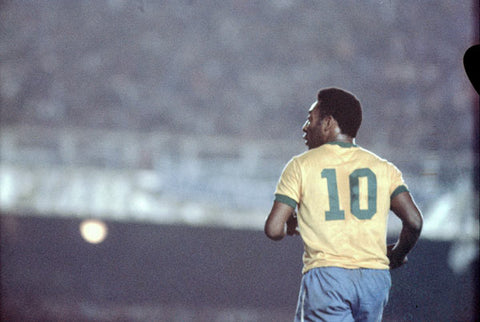
The number 10.
Unlike any other sport, the number 10 in football carries with it a sense of legacy and prestige, a sign of respect and recognition as a leader. It has taken on a symbolic meaning, and wearing it on your jersey has become the holy grail in football. What is the actual role of a number 10 and why is it so special?

Arsenal and Sheffield Wednesday played for the first time with numbered shirts in 1928. Jersey numbers were originally created to identify certain positions in a tactical formation. The numbers 1 to 11 were assigned to starting players according to their position on the field. The player holding that position was assigned the corresponding jersey with the correct number. Higher numbers were not used for substitutes until 1965, so until then 1 to 11 represented every position and every player on the field. There were also no player names on jerseys, so it was fairly simple.
A number 10 was predominantly an attacking midfielder with an eye for the goal and for amazing passes. He was the equivalent of a conductor in an orchestra. He was the playmaker. He controlled everything offensively around him and allowed the team to “play the music.” As a result, the number 10 became more than a number on a jersey.

In our minds, it’s also more than just the men who wore the number. We are most impressed by the number 10’s who were the creators, the magicians, the legendary trailblazers who had seemingly endless talent and ability to do the impossible. Spotting the run, the pass, dropping a shoulder, turning on a dime, all without a hint of hesitation. These are the moves you tried to emulate as a kid on the playground. These are the players you would have paid good money to see play live.
Elusive for much of the game, yet so often the match winner, these players are the embodiment of technique, grace and skill. These playmakers often rely on a combination of touch, vision, creativity, control and (most importantly) executive function. The classic number 10’s role was to create opportunities and score wherever possible. Teammates sprang into life around the player, anticipating knife-through-butter killer balls and deft touches to open up defenses
Pelé, Diego Maradona, Baggio and Platini were just a few who donned the number 10 while dominating the pitch. Generations of children grew up idolizing everything about them, from their fancy footwork to their passing panache, to the shirts on their backs and extending to what number they wore.
The ideal that developed around the number 10 was that he was eloquent and feisty at the same time. If you needed a last-minute goal to win the league title or advance to the knockout stages of the World Cup, the number 10 was your go-to man. From Platini to Totti, the classic trequartista has been a source of inspiration for millions of what’s possible on the pitch.

Like a gentleman not dirtying his own hands in the engine of a car, but choosing instead to simply drive it to beautiful places, the number 10 wasn’t really known for his defensive abilities. This is why they always tend to have a bodyguard behind them in the shape of a defensive midfielder. Defense would do all the dirty work, while the number 10 had license to roam about and work his magic.

There may be no better example than Pelé. Whenever you see a yellow jersey with the number 10 on it, you automatically cast your mind back to Pelé. Pelé oozed class, and to this day he is seen as the greatest players ever to play the game. Pelé is still the youngest player to have ever scored a goal for Brazil. He also managed to help his country win three World Cups. You cannot watch any footage of a World Cup without reference to Pelé.
Pelé has revealed that he was given the number 10 shirt by accident ahead of the 1958 World Cup. He arrived at the tournament in Sweden as a 17-year-old kid. Despite the number 10 shirt usually being awarded to the team's playmaker, the former striker has explained why he became the beneficiary of the famous jersey.

"The No.10 jersey was given to me at a World Cup match in 1958," he said. "Nobody was that important to wear the number 10 and even though I was not the oldest player in the squad, it coincidentally dropped to me to wear at the World Cup," he told SporTV News. The rest is history.
Which number 10 made you fall in love with the game? Join the conversation.
Be a TENLEGEND™
